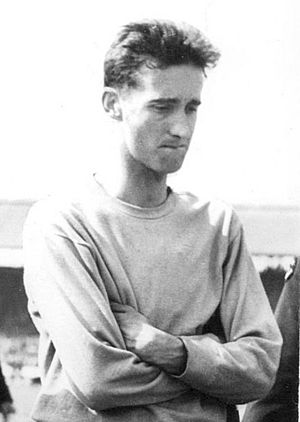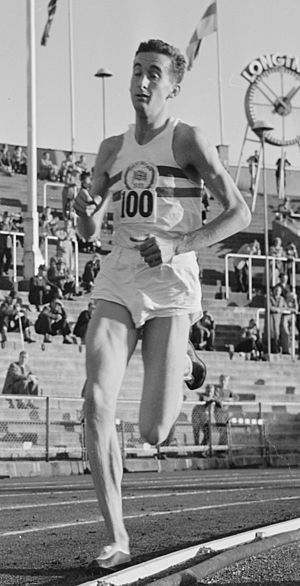Gordon Pirie facts for kids

Pirie in 1956
|
||||||||||||||||||||
| Personal information | ||||||||||||||||||||
|---|---|---|---|---|---|---|---|---|---|---|---|---|---|---|---|---|---|---|---|---|
| Born | 10 February 1931 Leeds, England |
|||||||||||||||||||
| Died | 7 December 1991 (aged 60) Lymington, England |
|||||||||||||||||||
| Height | 1.88 m (6 ft 2 in) | |||||||||||||||||||
| Weight | 65 kg (143 lb) | |||||||||||||||||||
| Sport | ||||||||||||||||||||
| Sport | Running | |||||||||||||||||||
| Club | South London Harriers | |||||||||||||||||||
| Achievements and titles | ||||||||||||||||||||
| Personal best(s) | 5000 m – 13:36.8 (1956) 10000 m – 29:15.49 (1960) |
|||||||||||||||||||
|
Medal record
|
||||||||||||||||||||
Douglas Alistair Gordon Pirie (born February 10, 1931 – died December 7, 1991) was a famous English long-distance runner. He competed in big races like the 5000 and 10,000 meters at the Olympic Games in 1952, 1956, and 1960. He won a silver medal in the 5000 meters at the 1956 Olympics. Gordon Pirie was born in Leeds, England, and grew up in Coulsdon, Surrey. He ran for a club called the South London Harriers. He passed away in Lymington, England, from cancer.
Contents
Gordon Pirie: A Running Legend
Early Victories and World Records
In 1955, Gordon Pirie won the BBC Sports Personality of the Year award. This was a big achievement for him. That same year, he even beat Emil Zátopek, who was a triple gold medalist in distance running from the 1952 Olympics. Pirie was also an amazing cross-country runner. He won the English Championship three times.
Gordon Pirie broke five world records during his running career. His most amazing year was 1956. On June 19, in Bergen, Norway, he ran the 5,000 meters in 13 minutes and 36.8 seconds. He beat Vladimir Kuts from the USSR and improved his own best time by 25 seconds. A few days later, on June 22, in Trondheim, Norway, he broke the world record for the 3,000 meters with a time of 7:55.5. Then, on September 14, in Malmö, Sweden, he set a new record for the 3,000 meters with an even faster time of 7:52.7.
Competing at the 1956 Melbourne Olympics
Later in 1956, the Olympics were held in Melbourne, Australia. Pirie raced against Vladimir Kuts in the 10,000 meters. Kuts was a very aggressive runner who would speed up suddenly. This made it hard for Pirie, who had a longer stride. Even so, Pirie stayed with Kuts for most of the race. In the last mile, Kuts made a final sprint that Pirie could not match. Kuts later said that if Pirie had stayed with him, Kuts would have given up.
In the 5,000 meters race, Pirie won the silver medal, finishing second behind Kuts. Another British runner, Christopher Chataway, was also in the race. Kuts set a very fast pace, faster than Chataway had ever run. Chataway got a stomach cramp and slowed down. This created a gap between Kuts and the British runners. Pirie and Derek Ibbotson ran past Chataway. Kuts used this chance to pull far ahead. He won the race by 11 seconds, which was the biggest winning margin for this event in Olympic history. Pirie ran very strongly in the final part of the race and held off a challenge from Ibbotson to secure his silver medal.
Between the Olympic Games
Pirie also represented England at the 1958 British Empire and Commonwealth Games. He finished fourth in both the 1-mile and 3-mile races.
The 1960 Rome Olympics
The 1960 Rome Olympics took place in the middle of summer, and it was very hot. Pirie and other British athletes wanted to go to Rome early to get used to the heat. They offered to pay for their own trip, but they were not allowed. Officials said, "we travel as a team." Because of this, Pirie and his teammates were eliminated in the 5,000 meters heats. This left the 10,000 meters as Pirie's only chance for an Olympic medal.
In the 10,000 meters, Pirie planned to stay with the favorite, Murray Halberg from New Zealand. Halberg was known for making a strong burst of speed in the last mile to win races. However, Halberg might have been tired from an earlier race. As the 10,000 meters continued, Halberg fell behind the leaders. Pirie realized that both he and Halberg had lost contact with the front runners.
After His Olympic Career
After the Olympics, some parts of the press were critical of Pirie. However, he continued to run. In 1960, Pirie ran a mile in under four minutes in Dublin, finishing in 3:59.9.
Gordon Pirie also became very good at orienteering, which is a sport where you use a map and compass to find your way. He won the British Orienteering Championships in its first two years, 1967 and 1968. He also won the first Jan Kjellström International Festival of Orienteering. Pirie even represented the UK at the World Orienteering Championships in 1966 and 1968.
The Guinness Book of Records in 1998 listed Gordon Pirie for the "Greatest Mileage." It said that he had run a total distance of 347,600 kilometers (about 215,988 miles) over 40 years, up to 1981. That's like running around the Earth almost nine times!
Gordon Pirie's Running Advice
Gordon Pirie wrote a book called Running Fast and Injury Free. In his book, he suggested a different way of running. He said that runners should land on the middle of their foot first, instead of on their heels. He also recommended taking 3-5 steps per second. Pirie believed this style would help runners avoid getting tired, prevent foot injuries, and stop them from wasting energy by bouncing up and down too much.
He also wrote about working with Adolf Dassler, who founded Adidas. They designed running shoes with stronger toes instead of stronger heels. This design was meant to be more durable for Pirie's suggested running style.
See also
 In Spanish: Gordon Pirie para niños
In Spanish: Gordon Pirie para niños


